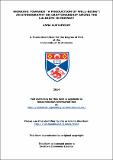Files in this item
Working towards “a production of well-being” : an ethnography on craftsmanship among the Lulesámi in Norway
Item metadata
| dc.contributor.advisor | Harris, Mark | |
| dc.contributor.author | Gustafsson, Anna | |
| dc.coverage.spatial | 229 | en_US |
| dc.date.accessioned | 2015-04-22T15:10:05Z | |
| dc.date.available | 2015-04-22T15:10:05Z | |
| dc.date.issued | 2015-06-25 | |
| dc.identifier | uk.bl.ethos.644851 | |
| dc.identifier.uri | https://hdl.handle.net/10023/6538 | |
| dc.description.abstract | This thesis is an ethnographic study of craftsmanship among the Lulesámi in Northern Norway. The study, which is based on an apprentice-style methodology, focuses in particular on the role and significance of making and wearing the gáppte, a characteristic Sámi dress. While the gáppte is often employed to visually define and distinguish the Sámi in relation to other people, my aim is to move beyond such a common interpretation and unfold the garment’s everyday aspects and explore how its production and use are interwoven with the Lulesámi’s emphasis and ongoing creation of personal and social well-being. The chapters address, in their different ways, the three main themes of this study. The first is concerned with the various ways in which the gáppte and its use affect people’s sense of self and relations to others, and the factors influencing such diverse experiences. The second theme focuses on how the learning to make the garment, rather than involving a fixed set of skills, is based on an ongoing practical and sensuous engagement with the world. I demonstrate that novices not only learn the technical skills of producing a garment to be worn, but that they are also encouraged to develop certain social skills and virtues for living a good life. The third theme is constituted by an examination of the productive activities within the domestic sphere, which often go unnoticed as they cannot easily be seen or measured through tangible evidence, but which affirm and strengthen the making of a convivial society. Through the analysis I draw and build on current anthropological debates on material culture by showing how craftsmanship is a self-transforming experience which encompasses a complete way of being, traversing and merging immaterial and material realms of life. I also wish to contribute to feminist debates by drawing attention to how the ‘personal’ and ‘domestic’ are intimately intertwined with larger historical, political and social processes. | en_US |
| dc.language.iso | en | en_US |
| dc.publisher | University of St Andrews | |
| dc.rights | Creative Commons Attribution-NonCommercial-NoDerivatives 4.0 International | |
| dc.rights.uri | http://creativecommons.org/licenses/by-nc-nd/4.0/ | |
| dc.subject | Craftsmanship | en_US |
| dc.subject | Well-being | en_US |
| dc.subject.lcc | DL442.L3G8 | |
| dc.subject.lcsh | Sami (European people)--Norway | en_US |
| dc.subject.lcsh | Workmanship--Social aspects--Norway | en_US |
| dc.subject.lcsh | Well-being--Norway | en_US |
| dc.subject.lcsh | Sami (European people)--Clothing--Norway | en_US |
| dc.title | Working towards “a production of well-being” : an ethnography on craftsmanship among the Lulesámi in Norway | en_US |
| dc.type | Thesis | en_US |
| dc.type.qualificationlevel | Doctoral | en_US |
| dc.type.qualificationname | PhD Doctor of Philosophy | en_US |
| dc.publisher.institution | The University of St Andrews | en_US |
| dc.publisher.department | Department of Social Anthropology | en_US |
This item appears in the following Collection(s)
Except where otherwise noted within the work, this item's licence for re-use is described as Creative Commons Attribution-NonCommercial-NoDerivatives 4.0 International
Items in the St Andrews Research Repository are protected by copyright, with all rights reserved, unless otherwise indicated.


